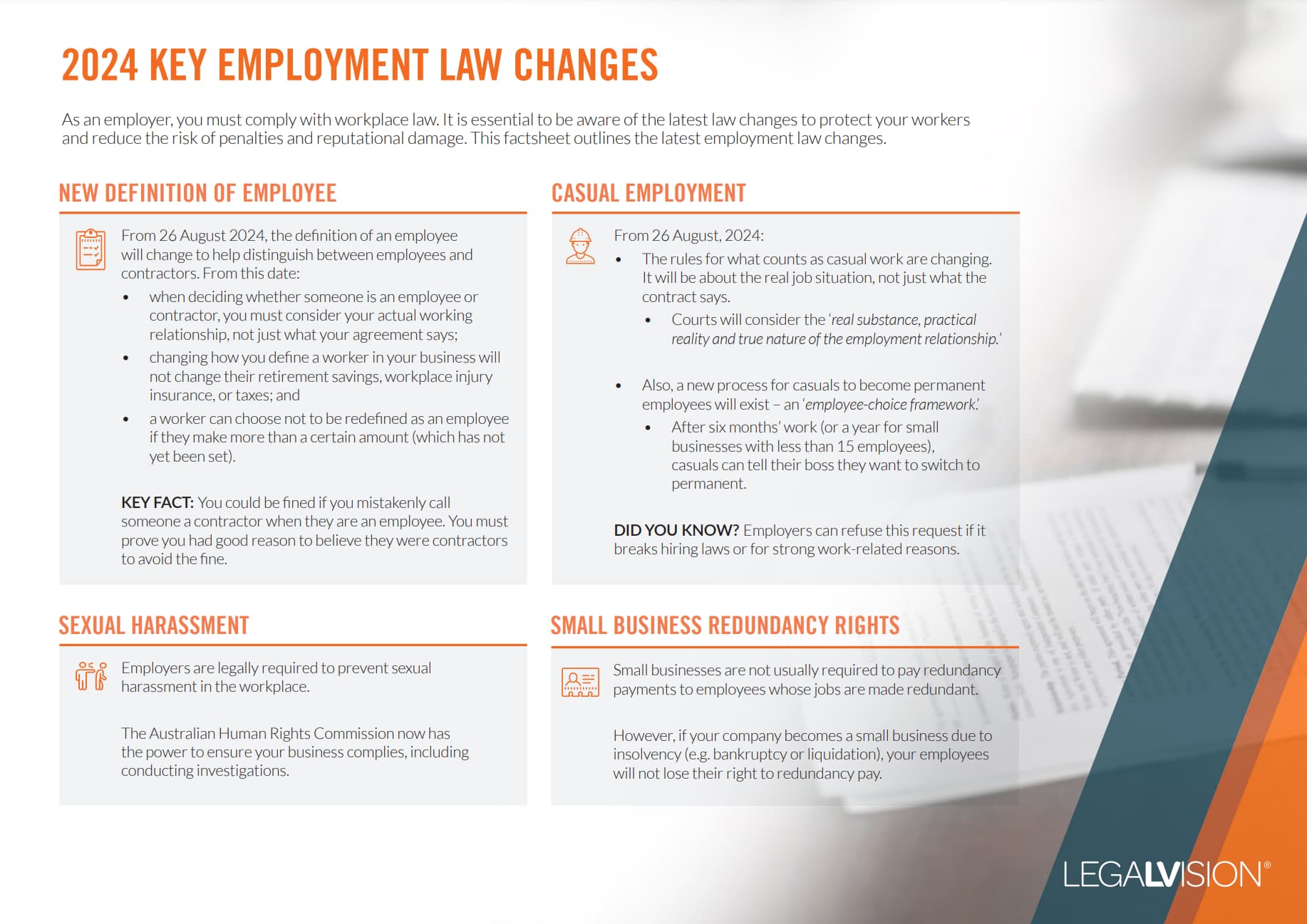As an employer, you may be concerned with an employee’s performance and the impact it is having on your business. In circumstances where an employee is underperforming, a performance improvement plan is often an effective way of assisting them with getting back on track. Additionally, if your employee does not improve, having a performance improvement plan in place may mitigate the risk of any successful unfair dismissal claims.
This article will discuss performance improvement plans in relation to:
- what to include in them;
- how to approach them; and
- why they are important.
What is a Performance Improvement Plan?
A performance improvement plan is a document that lists where an employee is underperforming and where they can improve. It creates clear expectations and objectives for your employee to reach within a specified timeframe.
These plans are very flexible and can be tailored to address any issue. For example, you could draft a performance improvement plan to address an employee failing to meet their key performance indicators.
It is important to remember that these plans are intended to help enhance an employee’s performance, and therefore you should assess whether a performance improvement plan is appropriate and will help the employee improve. For example a performance improvement plan should not be used to address any misconduct issues. Misconduct issues need to be addressed separately.
What to Include in a Performance Improvement Plan?
If you have decided that a performance improvement plan is the best approach, you should ensure that you include the following key terms in your draft.
1. Objective
This section should outline the key goal of the plan. For example, you may want the employee to improve their time management. You should be specific about how exactly the employee should improve.
2. Required Outcome
You should outline the end result that you want your employee to achieve. In doing so, it will be beneficial to include the:
- specific level you require the employee to perform at;
- strategies they may use to achieve this; and
- actions that are expected of them.
You may also find it helpful to include the responsibilities of each party in reaching this outcome. This will create effective communication between you and your employee, and they should feel supported and understood during the performance improvement process.
3. Support
You should also include a section that details how you will help your employee reach the outcomes in the performance improvement plan. You may choose to provide your employee with support measures, including:
- extra training;
- regular feedback; and
- a manager supervising them.
4. Consequences
This is an important section where you should detail the relevant consequences of your employee not meeting the outcomes in the plan. If there is an absence of improvement, you should undertake measures such as:
- providing a written warning;
- pursuing formal disciplinary action; or
- termination of the employee.
Moreover, the plan should include a start date and an end date. There should also be dates to review the employee’s performance. Finally, both you and your employee should sign the plan to show that you have read and understood your respective responsibilities.
Continue reading this article below the formHow to Approach a Performance Improvement Plan With an Employee?
When drafting a performance improvement plan, it is essential to be transparent with your employee and ensure that they are aware of the performance issue.
You may wish to introduce the performance improvement plan in a formal meeting. During the meeting, you should:
- address the performance issues;
- provide your employee with an opportunity to respond to these issues; and
- discuss and sign off on the terms of the plan.
When the plan is in action, you should also monitor the employee’s improvement. This can include regular check-ins and discussions around reassessing the plan and further opportunities for support. It is essential that you keep records of any meetings or changes to the plan. These records can assist you in the event that you decide to terminate the employee.
Once the timeframe of the plan has ended, you should assess whether your employee has successfully met the outcomes. If they have not, you may extend the plan or pursue alternative measures, including disciplinary action. Any disciplinary action that you take must be reasonable in the circumstances.

As an employer, it is essential to understand what employment laws have changed and their implications for your business — particularly the changes to the Fair Work Act 2009 through the new Closing the Loopholes legislation.
What Are the Benefits of a Performance Improvement Plan?
1. Minimises Employee Turnover
Instead of dismissing an employee for underperforming, you have the opportunity to provide them with room to improve. In addition, these plans allow you to upskill your current employees and save time and money by recruiting new employees to fill the position.
2. Better Accountability
For employees, it is easier to be motivated to improve knowing that there are review dates and employer check-ins coming up. Additionally, the consequences of employees not meeting the required performance outcomes help to hold them accountable.
3. Provides Documentation
Having performance improvement plans in writing protects employees from unfair dismissal claims. In addition, assuming the plan is written carefully with measurable and realistic goals proves that the employee received an opportunity to improve.
Case Example
In a recent case concerning a performance improvement plan, an employee alleged that his employer forced him to resign using an unreasonable plan. He argued that the daily target and the changing dates and times of his plan contributed to his forced resignation. However, the Fair Work Commission considered the performance improvement plan fairly and agreed with the employer that the employee was given several options aside from resignation.
This case shows the importance of creating a detailed and effective performance improvement plan to avoid liability in court.
Key Takeaways
A performance improvement plan is a document that lists how an employee is underperforming and how they can improve. These plans help provide strategies and support systems available to improve performance. Moreover, they can:
- minimise employee turnover;
- provide accountability;
- set clear expectations; and
- ensure that you have adequate documentation in the event of an unfair dismissal claim.
If you need assistance in drafting your performance improvement plan, our experienced employment lawyers can assist as part of our LegalVision membership. For a low monthly fee, you will have unlimited access to lawyers to answer your questions and draft and review your documents. Call us today on 1300 544 755 or visit our membership page.
We appreciate your feedback – your submission has been successfully received.











